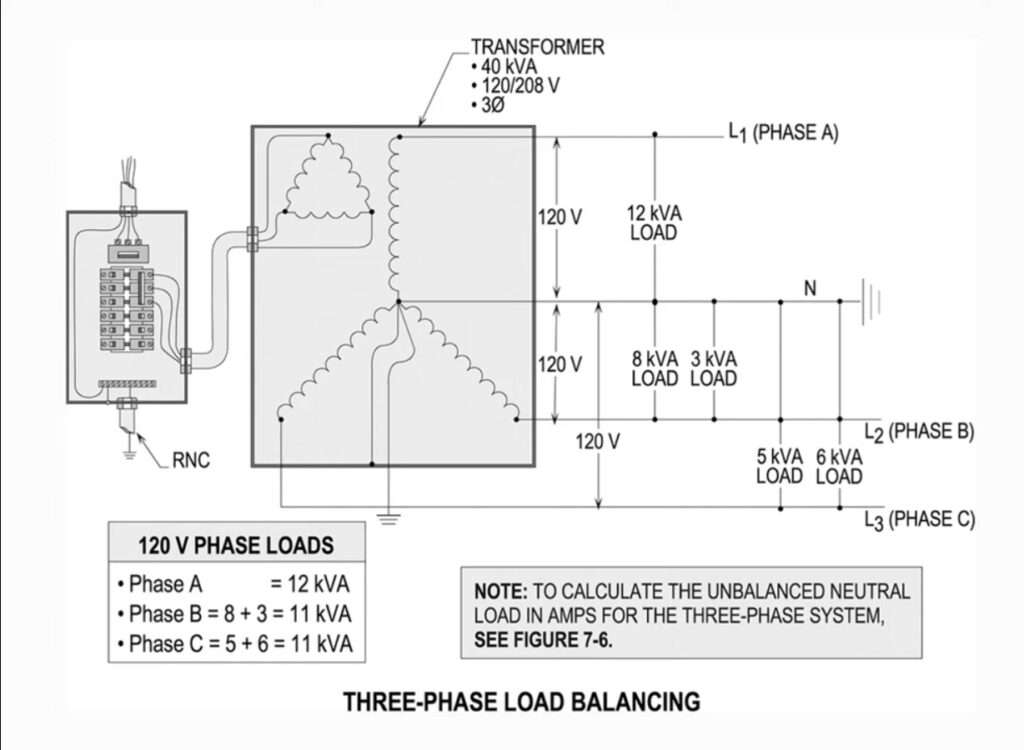Understanding Three-Phase Load Balancing
What is Three-Phase Load Balancing?
Three-phase load balancing is a crucial aspect of electrical power distribution that ensures equal power distribution across all three phases. When the loads on each phase are uneven, it leads to an unbalanced system, which can cause inefficiencies, overheating, and reduced equipment lifespan.

Examining Three-Phase Load Distribution
To understand three-phase load balancing, let’s analyze a system with three phases: A, B, and C. Consider a scenario where we have:
- Phase A: 12 kVA
- Phase B: 8 kVA + 3 kVA = 11 kVA
- Phase C: 5 kVA + 6 kVA = 11 kVA
From this distribution, we see that Phases B and C are balanced at 11 kVA each, whereas Phase A carries a heavier load at 12 kVA. This indicates an unbalanced condition that needs to be addressed.
Identifying and Calculating Load Imbalance
To determine the load imbalance, engineers refer to specific calculations and methods. Based on above Figure, the unbalanced load can be quantified using a standardized formula that compares the differences in phase loads.
Transformer Analysis in Load Balancing
In this scenario, we are working with a 40 kVA transformer rated at 122/8 volts, three-phase, four-wire. The phase loads are distributed as follows:
- Phase A to Neutral: 12 kVA
- Phase B to Neutral: 8 kVA + 3 kVA = 11 kVA
- Phase C to Neutral: 5 kVA + 6 kVA = 11 kVA
Since the total power is divided among the three phases, achieving balance ensures stability and efficiency in the electrical system.
Correcting an Unbalanced Load
To correct the imbalance in a three-phase system:
- Reallocate Loads – Redistribute the connected loads to ensure each phase carries a similar amount of power.
- Use Load Balancing Equipment – Devices such as automatic load balancers and phase-shifting transformers can help correct imbalances.
- Regular Monitoring – Continuous monitoring of phase loads helps detect and rectify imbalances before they become problematic.
- Refer to Standard Calculation Methods – Using established calculation techniques, such as those found in above Figure, ensures accuracy in determining and addressing unbalanced loads.
Importance of Three-Phase Load Balancing
Maintaining a balanced three-phase system offers several benefits:
- Increased Efficiency: Reduces power losses and optimizes transformer performance.
- Prevention of Overheating: Prevents excessive heating in electrical components.
- Extended Equipment Lifespan: Balanced loads reduce stress on electrical infrastructure.
- Stable Voltage Levels: Ensures consistent voltage across all phases, improving system reliability.
Conclusion
Three-phase load balancing is a fundamental practice in electrical engineering that enhances system performance and prevents inefficiencies. By understanding load distribution, calculating imbalances, and applying corrective measures, engineers can ensure a stable and efficient electrical system. Utilizing resources such as above Figure for calculations helps in making accurate adjustments to maintain balance in three-phase systems.
ThreePhaseLoadBalancing, #ElectricalEngineering, #PowerDistribution, #LoadBalancing, #ThreePhasePower, #ElectricalSystems, #PowerQuality, #PhaseBalancing, #GridStability, #IndustrialPower, #SmartGrid, #ElectricalLoad, #PowerEfficiency, #EnergyManagement, #VoltageStability
